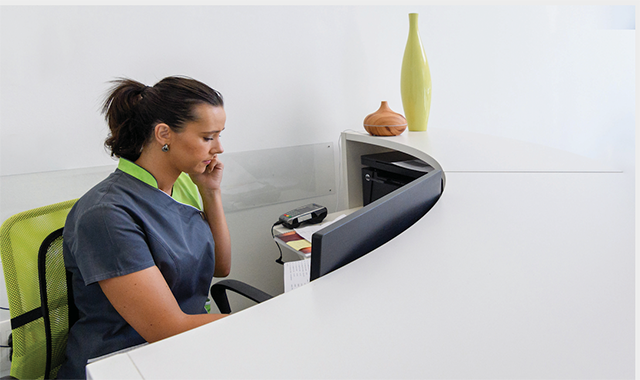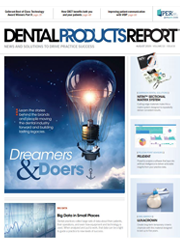Improving patient communication with VoIP
New technology will help your front office to provide quality customer service.

Technology and its continued progress is really incredible. The ability to share and disseminate knowledge is allowing for people to learn at an amazing rate. At one time, all we learned was pretty much limited to the information we gained from others in the village.
Now, according to industrytap.com, “nanotechnology knowledge is doubling every two years and clinical knowledge every 18 months. But, on average, human knowledge is doubling every 13 months.” That’s a pretty substantial increase in what we know.
The frightening part of all of this is simply trying to keep up. Our brains are still pretty much working at the speed of the village mentioned above, while the world and the knowledge base accelerates at a rate that’s practically incomprehensible. Heck, if clinical knowledge doubles every 18 months, that means when you graduated from dental school, you only know a fraction or what was learned just while you were being trained!
Trending: Digitize your practice in a way that works for you
All of this means things are changing at an incredibly rapid pace and it takes a continued effort to stay “on the curve,” as it’s now almost impossible to stay “ahead of the curve.”
That’s one of the big reasons I’m a fan of lists. In this giant game of “whack-a-mole” we call life, often changes come at us so fast that a project we wanted to accomplish this quarter suddenly becomes forgotten as other things pop up in front of us and steal our attention. By creating lists and referring back to them, we can sort of rein in our distractions and apply the proper energy with the right directions.

Look under the hood
It also pays to take a look at technologies and/or systems that haven’t been changed or updated in quite a while. Looking under the hood at some of these situations often can expose a problem or an inefficiency that needs to be corrected. Continuing down a path simply because “we’ve always done it that way” isn’t necessarily a good reason to continue doing it that way. In fact, often I find that is the exact reason we need to change whatever “it” is.
Now, I won’t disagree that sometimes things can stay the same. Change simply for the sake of change is easily a fool’s errand. However, I think no change simply for the sake of no change can easily be just as big a mistake.
What I’m talking about here is evaluating present systems and exploring options to improve. If those options don’t exist or are currently too expensive to correct, make note of that and file it away so that you can come back to it in the future. However, sometimes these types of evaluations can have a major impact.
Related reading: How to ensure front desk marketing finesse
The changing telecom industry
This year, one of the things I decided to look at in my practice was telecommunications. Over the years, we’ve seen incredible changes to the way data is moved throughout the world.
We originally started out by moving bits and bytes over the copper wires of the existing phone networks. As technology advanced, research and development created much more efficient and reliable ways of doing that. Fiber optic trunk lines are now the norm and those tiny strands of glass are what carries our information around the planet in the blink of an eye.
Needless to say, the technology to move our data has changed and evolved greatly since the early days of modems. Yet, the technology we use to carry voice to our offices has remained pretty much the same since those days of dial-up connections. Why is that? Probably the simplest explanation is big businesses tend to favor the status quo, especially when advancement requires a substantial infusion of cash and/or resources to spur it.
Continue reading on page two...
Overall, big companies don’t like to spend lots of cash to upgrade if they can continue on with the same business model, and will, for as long as possible.
The phone companies that bring voice to our offices have had little reason to change; therefore, most offices are using what’s referred to in the industry as “POTS” (Plain Old Telephone Service). This is the standard piece of copper wire that simply brings the phone call to your handset in the office.
In healthcare, the phone is the lifeblood and lifeline to your business, and it must be reliable. We need a solid, continuous connection with no cracks, pops or cutting out. A problem with your phone system can create a major problem for your practice.
Now, though, we’re seeing the change of traditional POTS to a new environment called VoIP (Voice over Internet Protocol). VoIP is pretty amazing because it transmits the phone call as digital data and not just electrical impulses down a copper wire. This means VoIP can also carry data, such as caller ID and potentially cleaner sound because the data is digital and transmitted as packets. Once those packets reach the office, our VoIP provider Weave (getweave.com) takes over, and that’s where the digital magic happens.
Trending: BIg data in small spaces
The magic of digital data
Why is this such a big deal? In a nutshell, it’s because the digital data can then interface with the data in your dental practice management software and bring an incredible amount of information to the administrative team who handles your phone calls.
This means a phone call to my office will have the caller identified and all of the needed data from the practice will then be provided as well. When the phone rings, a window on the PC will give the team member the name and other strategic demographic data from the software, including needed appointments, last recare, family members in need of an appointment, account balance, etc.
This incredible delivery of data happens instantaneously and allows the office to be better prepared to respond to patient inquiries and requests. The system also provides voice mail, HIPAA-compliant text messaging, after hours call routing and much, much more.
In addition to replacing your traditional phone service, VoIP will also provide other types of digital patient communication you may be paying for separately right now, such as appointment reminders, confirmations, text messaging, online reviews, email and text-to-pay.
One of the services I truly love is missed call texts. Instead of ever receiving a busy signal, patients calling my office are connected to the voicemail system. The best part? Even if they choose not to leave a message and simply hang up, the system sends them a text message immediately that’s pre-written by a member of my admin team. The note apologizes for missing the call and tells them someone will be calling them back in just a few minutes. Talk about impressing patients!
Related reading: Connecting with patients made easy and efficient
Choosing a VoIP provider
If this sounds exciting to you, here are some things to consider before moving to any VoIP provider:
- Consider the speed of your internet connection, which could affect voice quality
- Look at your contract with your POTS provider. Time your move with the end of the contract to avoid paying an early cancellation fee
- If you have an alarm system that uses a land line, make sure to talk to them about moving to a VoIP provider
- If you use some type of commercials on hold, you might need to change this as well
We made the jump to Weave in the spring of 2019 and have seen impressive results. Patients have been incredibly impressed with how our phone calls are being handled and I love the plethora of features the service brings.
If you’re looking to improve your business systems in 2019 and beyond, VoIP should make the list of things you need to explore. The changes it brings will be well worth it to you, your team and your patients.
